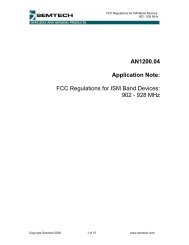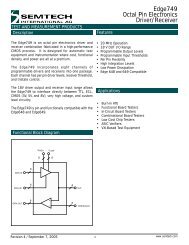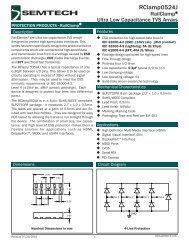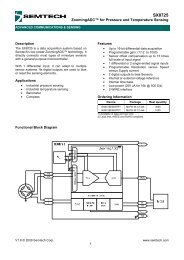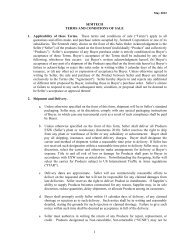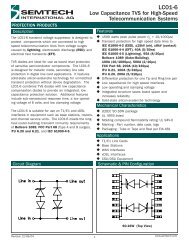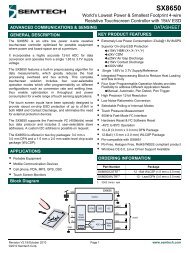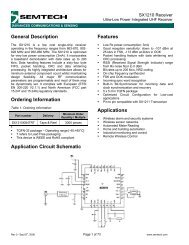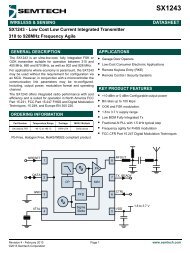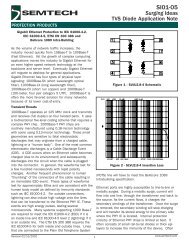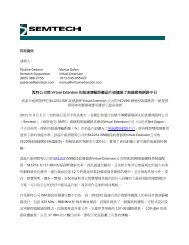PortDG0411 - Semtech
PortDG0411 - Semtech
PortDG0411 - Semtech
You also want an ePaper? Increase the reach of your titles
YUMPU automatically turns print PDFs into web optimized ePapers that Google loves.
Applications<br />
Portable Device Interfaces Protection<br />
Transient stress levels for each entry point into the system are<br />
defined by installation class. The six classes are defined as :<br />
Class 0 : Well protected environment<br />
Class 1 : Partially protected environment<br />
Class 2 : Well separated cables<br />
Class 3 : Cables run in parallel<br />
Class 4 : Multi-wire cables for both electronic & electrical circuits<br />
Class 5 : Connection to telecommunications cables<br />
and overhead power lines (Low density populated areas)<br />
A class 0 environment is considered the lowest threat level and has<br />
no transient stress requirements. The class 5 environment is the<br />
most severe and requires the highest transient stress level testing.<br />
Table 3 summarizes threat levels as a function of installation class.<br />
Values of voltage stress using the 1.2 x 50μs waveform are given.<br />
Corresponding current values are calculated by dividing the opencircuit<br />
voltages by the source impedances. The short-circuit current<br />
values are more useful in choosing a suppression element.<br />
The short circuit current stress levels are defined with the 8 x<br />
20μs waveform for power supply applications with a 2Ω source<br />
impedance. For data lines requiring a 42Ω source impedance,<br />
the short-circuit current waveform is defined as 8 x 20μs. For<br />
telecommunications applications, the open-circuit voltage is<br />
defined as 10 x 700μs and the short-circuit current is a 5 x 300μs<br />
waveform. The source impedance is given as 40Ω.<br />
The type of suppression element needed for IEC 61000- 4-5<br />
class surges depends upon the threat level and installation class.<br />
For power supply applications high power devices are required.<br />
A discrete device or an assembly may be required depending<br />
on the application. TVS diodes are the best choice for data line<br />
applications and secondary board level protection because of their<br />
superior clamping voltage characteristics and fast response time.<br />
Class<br />
0<br />
1<br />
2<br />
3<br />
4<br />
5<br />
WAVE<br />
FORMS<br />
Voltage<br />
Current<br />
Line-Line<br />
Zs = 2Ω<br />
Power Supply<br />
Unsym Lines<br />
(Long Distance Bus)<br />
Sym Lines<br />
Data Bus<br />
(Short Distance)<br />
Coupling Mode Coupling Mode Coupling Mode Coupling Mode<br />
Line-GND<br />
Zs = 12Ω<br />
Line-Line<br />
Zs =42Ω<br />
Line-GDN<br />
Zs =42Ω<br />
Line-GDN<br />
Zs =42Ω<br />
Line-GND<br />
Zs = 42Ω<br />
Voltage<br />
Current<br />
NO REQUIREMENT<br />
Voltage (n/a) 0.5KV (n/a) 0.5KV 1.0KV (n/a)<br />
Current 42A 12A 24A<br />
Voltage 0.5KV 1.0KV 0.5KV 1.0KV 1.0KV 0.5KV<br />
Current 250A 83A 12A 24A 24A 12A<br />
Voltage 1.0KV 2.0KV 1.0KV 2.0KV 2.0KV (n/a)<br />
Current 500A 167A 24A 48A 48A<br />
Voltage 2.0KV 4.0KV 2.0KV 4.0KV (n/a) (n/a)<br />
Current 1KA 333A 48A 95A<br />
Voltage (Note 1) (Note 1) 2.0KV 4.0KV 4.0KV<br />
Current 48A 95A 95A<br />
Voltage (1.2 x 50µs) (1.2 x 50µs) (1.2 x 50µs) (1.2 x 50µs) (1.2 x 50µs) (1.2 x 50µs)<br />
Current (8 x 20µs) (8 x 20µs) (8 x 20µs) (8 x 20µs) (8 x 20µs) (8 x 20µs)<br />
Note 1: Depends on class of local power supply system.<br />
Table 3 – IEC61000-4-5 Severity Levels<br />
Protection Design Guide ©2011 Copyright <strong>Semtech</strong> Corporation. All rights reserved. All Clamp products are registered trademarks of <strong>Semtech</strong> Corporation. 27



